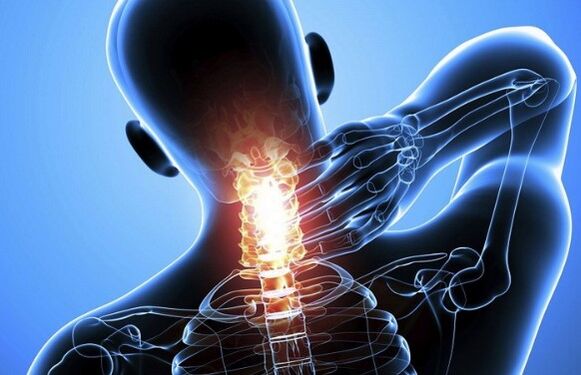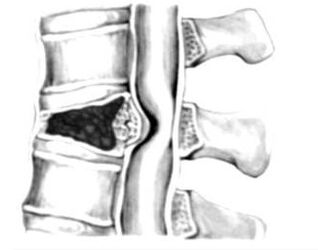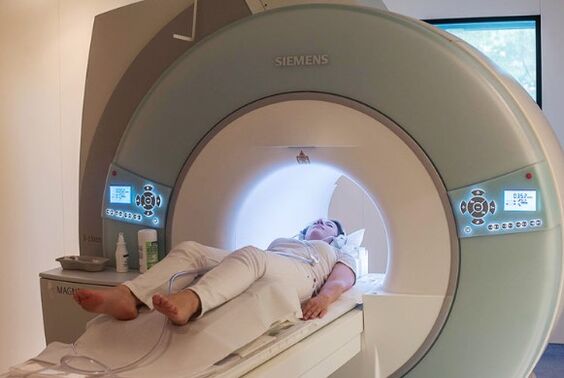Osteochondrosis is a complex degenerative destruction of the cartilage tissue located between the vertebral vertebrae. In this pathological phenomenon, discs themselves are affected, their changes in height, bone tissue is damaged in the cervical region.Pathology has similar symptoms with some diseases. The main thing is to notice the first signs of the body in time and submit to diagnoses with the necessary treatment, otherwise the osteochondrosis will begin to progress, cause migraine and blood circulation disorders. Basically, the pathology develops in people who have reduced motor activity. This is due to the fact that the exchange of mineral salts in the body is disturbed, which causes the thinning of connective tissue, as well as a decrease in its resistance.

Causal factors of the appearance of the disease
The neck is the most mobile part of the body, therefore, experiences a constant load, since it is obliged to keep the head in a certain position. Some factors may have a negative effect on this area of the body and form inflammatory processes on the connective tissues of the body.
The reasons for the development of pathological deviations in the cervical vertebrae are:
- Failure to comply with power rules, so excess weight is established;
- Functional change in the skeletal-mechanical system;
- hypodinamia;
- neck injury or spine;
- excessive physical pressure in the spine;
- stress;
- Long -term physical voltage of the cervical muscle frame;
- inheritance;
- Anomalies in bone development.
All these factors negatively affect the vertebrae of the cervical region, creating pressure, which leads to an involuntary tonic reduction of the smooth and skeletal muscles. What leads to the formation of hemodiscilative processes, a slowdown in the functions of metabolism, the development of dysfunctions and degenerative changes in the cartilage. The vertebrae begin to deform, acquiring a non -standard shape, and often go beyond the spine.
Symptoms of the disease
The initial stage of the pathological process is clearly visible for some signs.
- Cephalgic syndrome. It is formed during cerebral angiosasm, pressing cerebral brain nerves, as well as in the context of involuntary intracranial hypertension. It extends through the occipital part of the head, the neck, which affects the region of the shoulder and the upper limbs. Pain syndrome may resemble a prolonged increase in blood pressure (hypertension), an attack by angina pectoris, a violation of brain circulation and manifests itself in the form of a paroxysmal, constant or pulsating nature. Anxiety can increase, changes in humor arise, the concentration of attention decreases, a person becomes irritable, delicate;
- Dizziness occurs, the coordination of the movements is disturbed. Everything is accompanied by tinnitus, nausea, vomiting, disorientation appears. It is not always a sign of this pathology, since it can manifest itself as a result of average or internal otitis average, heart disorders, cerebral angioospasm or deteriorated nerve cell function. In addition, dizziness are often observed with a vestibular disorder;

Important!There are two types of dizziness. With non -systematic dizziness, evil appears, impressive, it is difficult for a person to be vertical. But at the same time, objects that fall into sight do not rotate. And with the systemic system, the circular movement of all objects is manifested, indicating violations in the work of the vestibular device, visual perception, muscle spasms. This is a distinctive sign of dizziness for osteochondrosis.
- Painful manifestations in the neck. Pain sensations are located not only in muscle tissues, but also on the shoulders, including the upper limbs. The appearance of pain suddenly develops and lasts a lot of time, and can have a short period. If the disease did not become a relapse, then the pain passes after a while, while there will be an accompaniment of a slight specific sound (Crunch);
- Arterial hypertension. When nervous endings are pinned, an acute jump in blood pressure is produced. Therefore, if an increased pressure is observed for a long time, this is not a symptom of osteochondrosis. High pressure in this disease is combined with headache, pain in the hands, compressing the chest, the cervical-brother of the back loses its sensitivity. The state of weakness, fatigue, lack of strength in the muscles of the upper extremities.
Table. Osteochondrosis classification of the cervical region.
What is the danger of the disease?

Pathology harms the entire human body. With osteochondrosis, blood vessels, nerve roots are squeezed closely, which leads to disorder encephalopathy, cephalgic syndrome develop, pathologies of heart rate, visual, respiratory systems, concentration and coordination processes are caused.
The disease tends to cause:
- several pathologies of the brain;
- Several vestibular, vascular and vegetable disorders of nature;
- Acute violation of spinal circulation with the development of ischemia or hemorrhage (stroke).
Diagnosis
Ways to diagnose intervertebral disks violations.
- Radiography. It is not effective enough in the last stage of the disease.
- Magnetic Resonance Tomography (MRI). A research method, which carries detailed information on the presence of deviations, pathologies of bone structure, connective tissue, either a hernia, with the clarification of its size, location and growth.
- Computer tomography using contrast. It allows you to determine the pathology in the vertebrae. The disadvantage in this study is the impossibility of determining the presence of compression of the spinal cord.
- Ultrasound dopplerography. The effectiveness of this method is to determine the reduction of blood circulation through blood vessels.
Treatment characteristics
In the treatment of osteochondrosis of the cervical region, they are based on the degree of disease, its characteristic clinical manifestations and its form. The treatment can be carried out as:
- Non -surgical therapy, whose purpose is to eliminate the symptoms, the manifestations of the disease to relieve the condition of the patient who uses medications and physiotherapy, therapeutic exercises, massage;
- Surgical intervention;
- Combined therapy. In this method, surgical intervention is carried out with additional drug treatment.

After a diagnostic exam, the specialist makes a final diagnosis and prescribes the necessary treatment depending on the clinical image of the disease. Basically, if the disease is in a stage that does not require surgical surgery, complex therapy is prescribed, which includes taking medications, the performance of therapeutic exercises and the passage of the curative massage course.
Medications
The doctor prescribes medications aimed at eliminating pain symptoms, inflammation and muscle tension, restoring cartilage tissues, replenishing the body with a mineral complex in the form of capsules, injections, ointments.
Therapeutic physical culture (exercise therapy)
Medical physical education is prescribed to restore blood circulation in the cervical region. The movements should not be sharp, with excessive rotation or head flexion. It is necessary to imitate listed movements. The exercises are carried out no more than two minutes. The exercises treatment complex includes head inclinations forward and backward, without performing the action until the end.
Basic exercises used to treat osteochondrosis.
- The pose of "bed" in the stomach is accepted. The hands rest on the floor, and the head and the torso rise. The back remains straight. It is necessary to be in this position for approximately two minutes in 2-3 approaches.
- The pose of "bed" in the stomach is accepted. The hands stretch along the body. The heads of the head are made to the right and left, trying to touch the floor with the ear. 6-7 approaches to each side.
- The pose "seated" is accepted. With an inhalation, there is a forward inclination, while trying to stretch to the chest with his head. When he exhales, he returns to his original position, with a slight slope of the head back. 10-15 approaches are made.
- In the "sitting" pose, the palms of the hands apply to the forehead, while making a pressing movement. The head also reaches palms, creating the effect of resistance. 2-3 30 second approaches are made.
- Circular head movementsthat are done very carefully and slowly to the right and left. Ten movements are made in each direction, avoiding dizziness.
Therapeutic massage
In the treatment of osteochondrosis, the specialist performs massage movements in the area of the cervical region, the necklace area and the upper back. This procedure must be performed in a liar position so that the patient's body is relaxed.
The main therapeutic massage techniques:
- Caressing- A technique in which the massive hand slides along the skin with a small degree of pressure, capturing the area of the head of the head and moving towards the top of the back.
- Tight- A technique during which a stronger effect on the skin, subcutaneous tissue and a surface layer of muscles are performed. The skin of the skin with the fingers occurs carefully, without going through the newspaper fabrics.
- Trituration- It consists of the change and stretching of tissues in several directions to heat the skin and blood flow to the collar region.
- Kneading- The most difficult technique that affects deep muscle tissue. It is carried out only on the recommendation of a doctor, with caution, since it can lead to a complication of the disease.

Physiotherapeutic treatment method
For the treatment of the pathology of the intervertebral discs of the cervical region, physiotherapy is prescribed.
- Drug electrophoresis-Contracting the ultrasonic-phisiotherapy procedure carried out under the modulated sinusoidal current.
- Laser therapy- This is the physiotherapy method, which activates blood circulation, eliminates the inflammatory process, reducing pain. Laser therapy is carried out to improve blood flow.
- Magnetotherapy- One of the methods that are based on the treatment of the exposure of magnetic fields, with the influence from which tissue edema is eliminated and pain is eliminated.
- Ultrasound therapy- The treatment allows you to relieve pain, the inflammatory process, while improving blood circulation.
Traditional medicine in the treatment of osteochondrosis of the cervical column
Popular methods to treat osteochondrosis will not work. This is due to the fact that these methods can temporarily relieve symptoms, but not to solve the main problem: the initial destructive effect on the spine. At home, plant components can be used as a support complex for the main therapeutic treatment established by the doctor.
For pain in the cervical region, you can use:
- Flying leaves (treated with boiling water, apply to pain approach);
- Raw potatoes and honey (the potatoes are rubbed until the suede is formed, mixed with honey in equal proportions and applies to the place of inflammation at least once a week);
- Mustard, pepper patch and alcohol rubbing (used for local irritating, greater blood circulation and pain elimination).

Preventive measures
To avoid the appearance of one of the dangerous diseases, it is necessary to observe certain rules all of his life. Following the correct lifestyle can be avoided by many diseases. However, there are situations in which the disease is inherited, and then it is worthy of your health. Dietary nutrition enriched with vitamins and minerals, as well as moderate physical activity will help keep the body and even stop the development of an initial disease.
Recommendations of doctors who will help prevent the appearance of the disease:
- Direct an active lifestyle, participate in swimming;
- Observe adequate nutrition;
- Eat food with calcium, magnesium (seafood, legumes, dairy products, vegetables);
- Diaries perform physical physical, especially if the work is associated with a constant sitting position;
- Use special orthopedic pillows and mattresses.
At any age, with osteochondrosis, it is worth performing a body exam, as well as performing a therapeutic physical culture with regular massage, then with the disease that can live for a long time and comfortably.


















